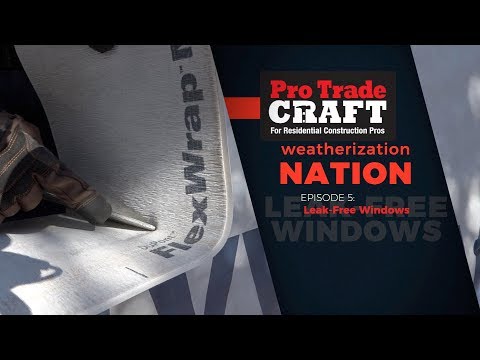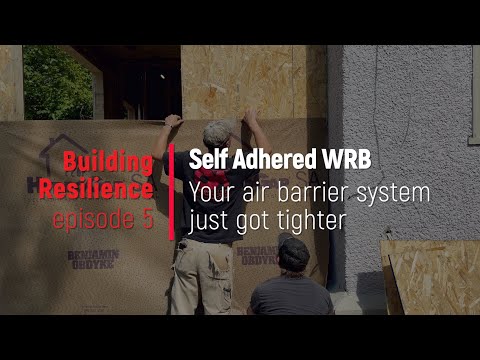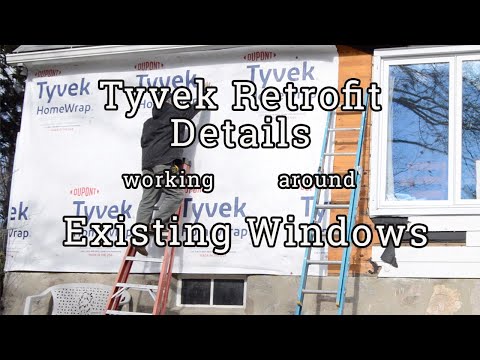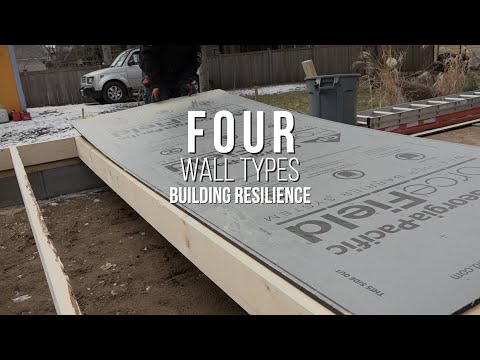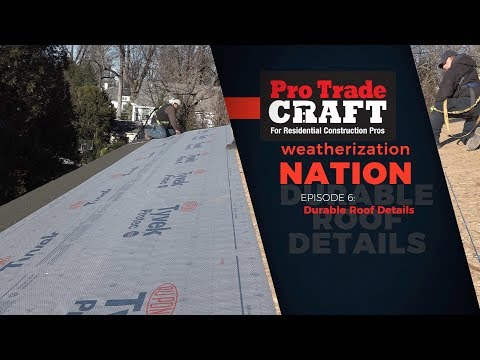Welcome to ProTradeCraft’s Weatherization Nation. A show about building smart from the start. See all of the episodes here. Last week we made a cold, wet hole into a warm and dry crawl space using Thermax polyiso foam board and smart plastic strategies…
Ray: We've found that when we do this with the gravel down, as you're working on it, you stretch it out and sometimes you can tear, rip or puncture the plastic.
So we take some of the leftover stuff that we've got and put a couple of strips down.
That way, when we put our six-mil or eight-mil on top of it and we're walking on top of it, we're not actually making holes in the vapor barrier.
They sealed the new crawlspace to the old building with Great Stuff and moved on to the framing. In this episode, we’re going to learn why the WRB is such a BFD.
Terrence Donohue: What we’re talking about today is Weather resistive barriers. Back in the day, they used to be tar papers, but tasr papers would dry out and crack, it did not handle UV very well. Nowadays we have longer spans between putting up our siding in between putting in our windows and doors.
Important factors about the WRB, weather resistive barrier, it's an air and water barrier, so when it rains, rain drains down the side of it and it continually moves water away from thew house.
Anothert thing that's important about a WRB is its permeability, which means the amount of vapor that it can transfer through. A lot of times duriung construction is during rainy days and you want that plywood to be able to dry out and not be stuck behind a vapor barrier that won't allow any moisture out.
Tyvek is not a vapor barrier
Let’s pause a second to make a point of that. ProTradeCraft travels all over the country to jobsites, and we see this a LOT:

Terence: Tyvek is NOT a vapor barrier. It allows vapor to pass through it and dry out through diffusion. A vapor barrier would be like a solid piece opf plastic that is not going to allow any air or moisture through it.
[Tyvek] is a water and air barrier, it allows vapor to pass through it, through permeability. Tyvek is not a vapor barrier.
Sketch Desk: Upgrading a WRB also to be an air barrier (WRAAB?)
Now that we have that cleared up let’s move to animation land for a strategy session
The general strategy for using house wrap as a water barrier is to cover all of the seams and gaps in the exterior sheathing, overlapping correctly. To upgrade Tyvek into an air barrier, seal the top and bottom as well as the vertical and horizontal seams.
Each layer should overlap to the outside so that water is continually directed away from the house. Seams are sealed against air leaks, and the WRB should extend to the bottom of the roof deck fort a continuous air and water barrier.
Git er DONE: Installing Tyvek
Begin at the bottom, making sure to seal the wall sheathing to the foundation with flashing tape. The WRB should overlap that seal.
They staple the bottom corner and tack the top, and then roll out the Tyvek, aligning the bottom to where it should be, and stapling minimally to make sure it is a smooth, tight fit.
With the bottom tight, Ray works his way up the sheet to staple it off using a cap stapler.
Terrence: There are several reasons here to use cap staplers and cap nails. A larger area of space holding it to the building, therefore less likely for wind to rip it away.
Secondly, as water travels down the building toward the cap, it is more likely to hit the cap and travel around the staple, instead of an old school slap stapler that may have damaged your WRB and provided an opening for water to get in.
Another thing to be careful of when putting in your cap staples, keep them away from where you'll put flashing. It could provide a void behind where water could leak in. Also, don't run the seam tape over the top of any of these caps, as that will provide bad adhesion and can allow water to work its way into the building as well.
At the ends where the WRB meets the existing house, they cut the Tyvek tight into the corner and staple it home. Later, they’ll cut about an inch off the end and use flashing tape to bridge the WRB and wall sheathing for an airtight connection.
Ray can finish off the stapling now that the WRB is where it ought to be.
Terrence: On this next row here, what we’re going to do is overlap a minimum of six inches. In most building practices, you want to overlap every product that you put on, that way, if water runs down the front of the building, it is going to be continually pushed to the outside.
You never want to have a situaltion of reverse-flashing, which would direct water into the building where it cannot dry out.
They cut the pieces to length on the ground and install the upper course off ladders, stapling the bottom in place first, and moving up.
Victor puts a couple of staples in the top corner, holds the sheet tight then he moves to the opposite end to pull it into place.
With the corners tight, he can staple off the bottom and the field, spacing staples about every 16 inches.
The same process holds for the other walls.
- Cut the sheet to length on the ground
- Fasten the bottom corner
- Align the top corner. On this wall, Victor can wrap the corner, beginning at the top, moving to the bottom, and then hitting the in-between.
- They pull the bottom tight, staple it, and move to the last corner, the top right, pulling tight down the edge and stapling.
Sometimes you need to adjust from where the initial staples were, which is one reason not to staple the field until the whole sheet is in good shape.
Again, overlapping the corners at least six inches stops sideways wind and water from sneaking into the wall system.
Seams are taped against air leaks, being careful not to tape over a cap staple, which can cause a fishmouth in the tape.
A J-roller or squeegee will wet the adhesive into the Tyvek. Most construction tapes and flashings are pressure-sensitive, so it is important to roll them into the substrate.
Finally, they fill in the gable end the same way they filled the rest, cut it to length, place the bottom of the sheet, spread it out, in this case, they cut it in place, staple it off, and seal the seams.
With the final piece in place, that’s what we call a WRAP—for the day, and the house.
Where we are, where we’re going
With the WRB perfectly installed, we are ready to cut some holes in it —for windows, which will be flashed and sealed into place for an airtight, watertight seal.
We’ll do that in-depth in the next episode of Weatherization Nation.
Previous: A Warm, Dry, Crawlspace
